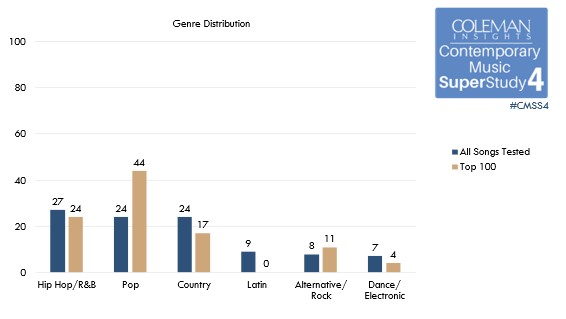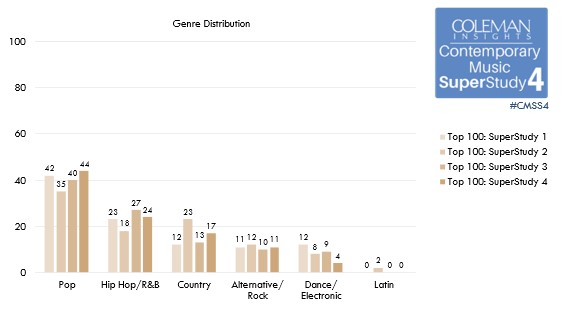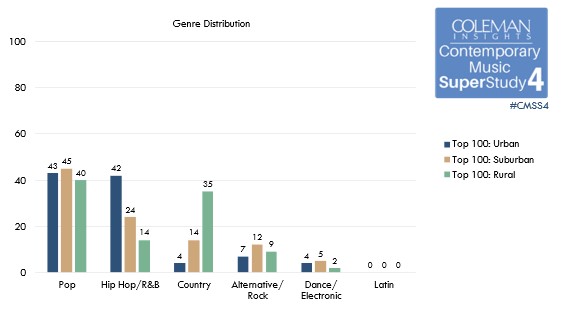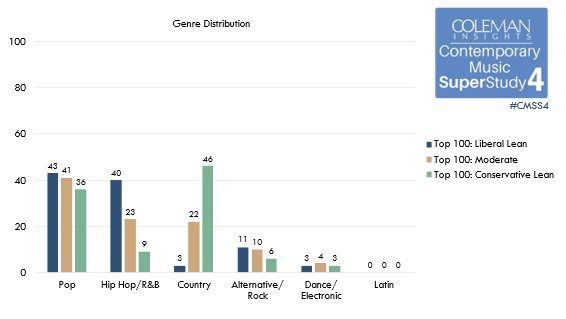
Coleman Insights is releasing findings from its Contemporary Music SuperStudy 4 in a three-part blog series, followed by a free webinar on Wednesday, May 11th at 2PM EDT/11AM PDT, in which the findings will be covered in greater depth. Details to register for that webinar are below.
Last week we focused on the major finding of our Contemporary SuperStudy 4, which revealed that while American and Canadian society has gradually reopened from the pandemic-caused lockdowns, consumer appetites for the newest music releases have not rebounded. This week we will delve into our findings about how specific genres fared in our fourth annual study, which look reasonably consistent with our previous findings.
The most consistent finding with previous editions of the Contemporary Music SuperStudy is that Pop titles dominate the Top 100 titles of the most-consumed songs of 2021. At 44%, Pop’s share of the Top 100 is substantially larger than the 24% presence of Pop titles in the study.

The only other genre that “overperforms” relative to its presence among All Songs Tested is Alternative/Rock. However, at 11% of the Top 100, Alternative/Rock titles do not make up a substantial share of the 100 songs consumers rated highest.
Hip Hop/R&B and Country, while somewhat underrepresented among the Top 100 relative to their presence in the test list we used for the study, are heavily present among the 100 songs consumers rate highest. Nearly a quarter—24%—of the Top 100 songs are Hip Hop/R&B; Country titles make up 17% of the 100 best-testing songs.
The hierarchy of genre representation among the Top 100 titles—Pop well out in front, followed by Hip Hop/R&B, Country, and Alternative/Rock—mirrors our findings from last year. This means that the stronger performance of Hip Hop/R&B last year relative to the two previous editions of our study has been retained, while the recovery of Country’s place among the most popular titles has yet to take place.

Also noteworthy is the drop-off in the presence of Dance/Electronic titles among the 100 songs consumers rate highest. While failing to make up a significant proportion of the Top 100 in any of the four editions of the Contemporary Music SuperStudy thus far, the presence of Dance/Electronic titles has dropped from 12% three years ago to 4% in this study.
As we’ve seen in previous editions of our study, Pop’s dominance is the result of its strong performance across numerous segments of the population. For example, when we divide listeners by geography, Pop titles make up at least 40% of the Top songs with listeners who say they live in Urban, Suburban, or Rural areas.

The performances of Hip Hop/R&B and Country titles, however, vary significantly by geography, which is a consistent finding from previous years. At 42%, Hip Hop/R&B titles make up almost as large of a portion of the Top 100 among Urban consumers as Pop does; the same is true for Country—at 35%—among consumers who live in Rural areas.
These geographic findings—as they have in previous years—line up very closely with our profiles of the Top 100 songs among consumers with different political viewpoints. Pop leads with consumers who describe their political affiliation as Liberal-leaning or Moderate, while Country makes up the largest share with those who describe their politics as Conservative-leaning.

The performance of Hip Hop/R&B looks almost completely opposite from Country from a political standpoint. At 40%, Hip Hop/R&B titles make up 40% of the Top 100 songs with Liberal-leaning consumers, while 3% of the best-testing titles with these same consumers are Country titles. Among Rural consumers, only 9% of the Top 100 songs are Hip Hop/R&B. Moderates, not surprisingly, fall somewhere in the middle with Hip Hop/R&B and Country titles—at 23% and 22%, respectively—making up nearly the same proportions of the Top 100 titles.
Next week, Tuesdays With Coleman will wrap up our in-depth coverage of Contemporary SuperStudy 4 when my colleague Sam Milkman will break down our findings by age-, gender-, and ethnicity-based demographics. He will explore how consumers’ appetites for contemporary music vary based on their usage of different platforms for consuming audio entertainment.
Registration is now open for the Contemporary Music SuperStudy 4 Deep Dive webinar, which takes place next Wednesday, May 11 at 2PM EDT/11AM PDT.

I think you need to make a distinction between Alternative and Rock. These 2 formats began a separation back in the early 00’s and now share almost no music. While some Alternative titles cross to Pop formats, songs that are exclusive to Rock do not. Lumping them together as Alternative/Rock suggests something that simply does not occur in today’s radio landscape. Rock records for whatever reason simply do not cross and to not correctly make that distinction slightly distorts the findings of the study.
There has been only ONE record in the last 15 years that has crossed from Rock to Pop formats and that was Disturbed’s cover of Simon & Garfunkle’s “Sounds Of Silence.” I do find it odd that Pop radio has not looked to some of the biggest hits at rock to try and establish them but for whatever reason they do not.
I would be curious to see how the numbers change in the study when Alternative and Rock are separated as they should be.